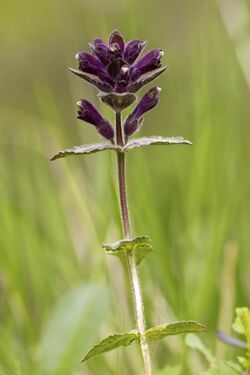Biology:Bartsia alpina
| Bartsia alpina | |
|---|---|

| |
| Flower in Norway | |
| Scientific classification | |
| Kingdom: | Plantae |
| Clade: | Tracheophytes |
| Clade: | Angiosperms |
| Clade: | Eudicots |
| Clade: | Asterids |
| Order: | Lamiales |
| Family: | Orobanchaceae |
| Genus: | Bartsia |
| Species: | B. alpina
|
| Binomial name | |
| Bartsia alpina | |
| Synonyms | |
|
Homotypic:
Heterotypic:
| |
Bartsia alpina is a species of perennial flowering plant, known by the common name alpine bartsia[1] or velvetbells. It is found in the mountainous regions of Europe and also occurs in Iceland, Greenland and north‐eastern Canada.
Description
Bartsia alpina is a hemiparasitic perennial plant with a woody rhizome, growing to a height of between 8 and 30 cm (3 and 12 in). The stem is erect and sometimes branched, hairy and purple in colour. The leaves are in opposite pairs, with oval leaf blades up to 25 mm (1.0 in) long and toothed margins. At the base of the plant, the leaves are green, but higher up they are tinged with purple. The corolla is dark purple and is about 20 mm (0.8 in) long. It is narrow at the base and has two lips, an obtuse upper lip and a smaller lower one, with three blunt, equal-sized lobes. It has four stamens fused to the corolla and two ovaries fused to the style. The fruit is an oval brown capsule.[2][3]
-
Botanical illustration by Jacob Sturm, 1796
-
closeup of flower
Distribution and habitat
Bartsia alpina has a European Arctic-montane distribution, and is also known from North America. It occurs in the mountainous regions of northern Russia, Finland, Norway and Sweden, and in the Alps and other mountains in Central Europe, as far south as the Pyrenees and south‐west Bulgaria; it also occurs in Iceland, Greenland and north‐eastern Canada.[3]
It has a very restricted distribution in the British Isles, occurring only in a few locations in upland areas in northern England, and in the central Scottish Highlands.[3] It used to occur in damp pasture, in basic flushes and runnels and wet, steep, species-rich banks, but it has largely been eliminated from these habitats by over-grazing and trampling by livestock. It has persisted better away from grazing animals in ledge communities on mica-schist crags.[4]
References
- ↑ (xls) BSBI List 2007, Botanical Society of Britain and Ireland, https://bsbi.org/download/3542/, retrieved 17 October 2014
- ↑ McClintock, David; Fitter, R.S.R. (1961). The Pocket Guide to Wild Flowers. London: Collins. p. 147.
- ↑ 3.0 3.1 3.2 Taylor, K.; Rumsey, F.J. (2003). "Bartsia alpina L.". Journal of Ecology 91 (5): 908–921. doi:10.1046/j.1365-2745.2003.00809.x.
- ↑ "Bartsia alpina". Online Atlas of the British and Irish Flora. https://www.brc.ac.uk/plantatlas/plant/bartsia-alpina. Retrieved 13 March 2020.
External links
Wikidata ☰ Q162552 entry
 |



